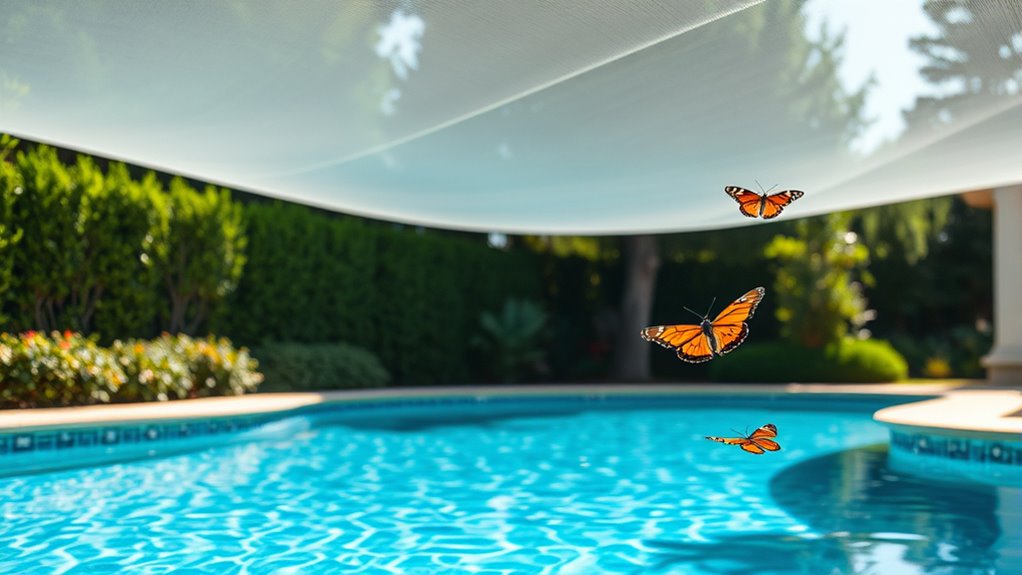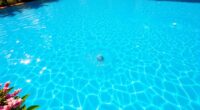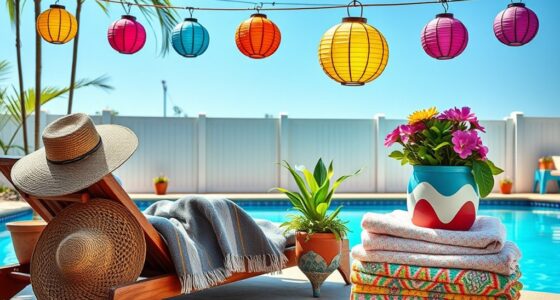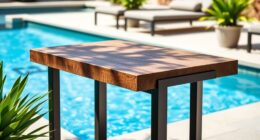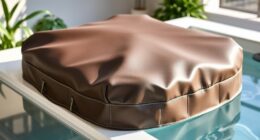To keep bugs away from your pool, maintain clean surroundings by removing leaves, debris, and standing water, and keep your pool’s chemical levels balanced. Install screens around the area and seal gaps in doors and windows to block insect entry. Use natural repellents like citronella and marigolds, and set up devices such as bug zappers or citronella candles. Regular upkeep and smart pest control strategies can make your pool bug-free; learn more to make your outdoor space even more pest-proof.
Key Takeaways
- Regularly clean and maintain the pool and surrounding area to reduce debris and insect habitats.
- Install mesh screens and seal gaps around doors, windows, and vents to block insect entry points.
- Use natural repellents like citronella, lavender, and marigolds to deter bugs around the pool area.
- Eliminate standing water in the yard by emptying containers and fixing drainage issues to prevent mosquito breeding.
- Deploy insect traps, bug zappers, and citronella candles to actively attract and reduce flying insects near the pool.
Maintain Proper Pool Hygiene and Chemical Balance
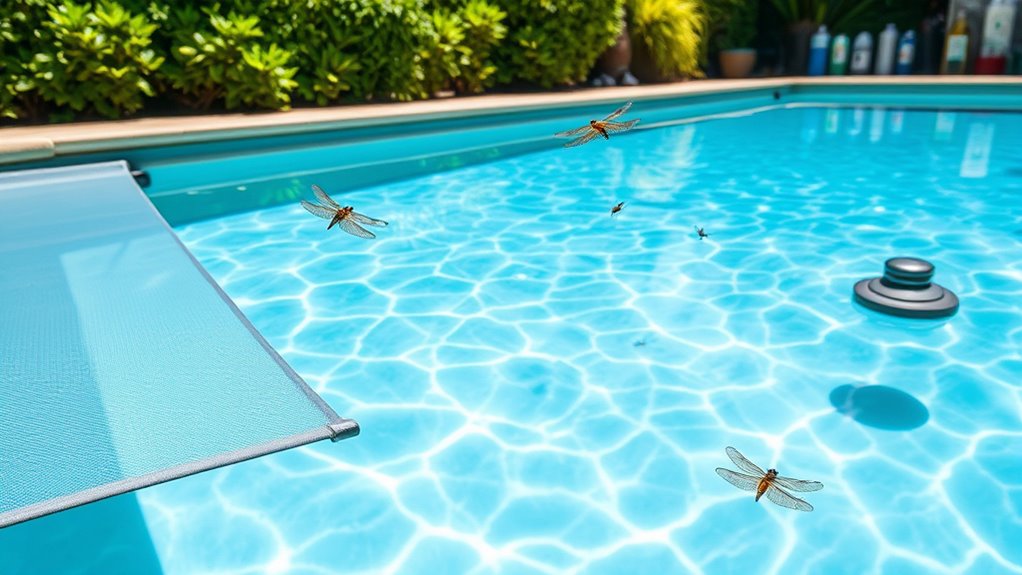
Maintaining proper pool hygiene and chemical balance is essential for preventing bugs from making your pool their home. Regularly skim the surface for leaves, insects, and debris, as clutter attracts bugs. Vacuum the pool floor weekly to remove dirt and organic matter that can create a breeding environment. Test and adjust chemical levels consistently—chlorine or other sanitizers should be kept at ideal levels to kill germs and discourage insects. Proper pH balance, between 7.2 and 7.6, helps maintain sanitizer effectiveness. Keep your filtration system running smoothly, cleaning filters regularly to prevent buildup. By staying proactive with pool maintenance, you create an environment that’s less inviting to bugs, reducing their chances of settling in and making your pool their favorite spot.
Use Physical Barriers and Screens
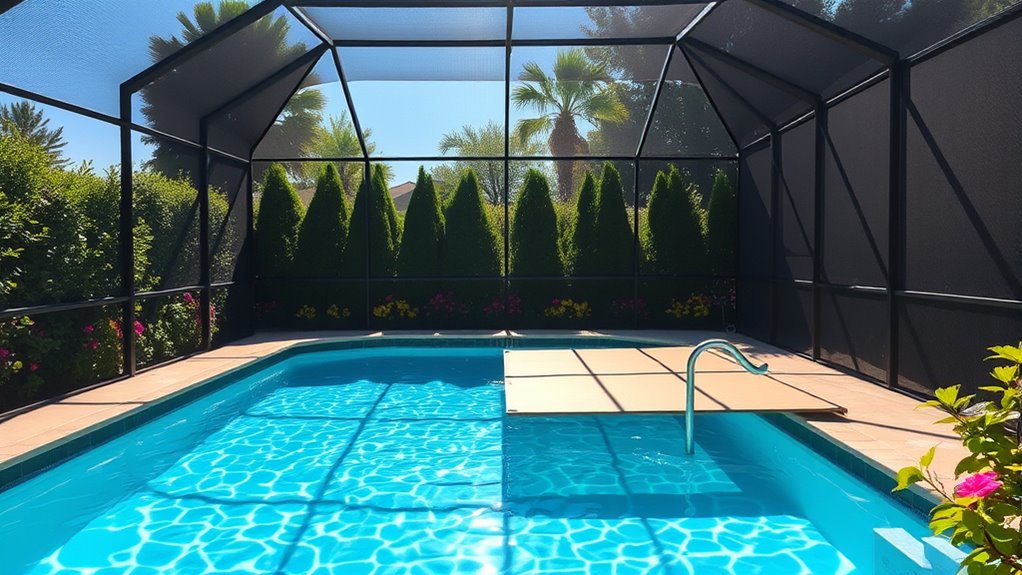
Installing mesh screens around your pool creates a strong barrier against insects. Make sure all openings are covered to prevent bugs from slipping inside. These physical barriers are simple, effective tools to keep your pool area pest-free. Incorporating self watering plant pots in the region can also enhance your outdoor experience and provide natural protection from pests. Ensuring proper screen placement can further improve effectiveness by reducing gaps and potential entry points. Additionally, consulting local zoning and permitting regulations can help ensure your screen setup complies with community standards.
Mesh Screens Prevent Insects
Mesh screens serve as an effective physical barrier that keeps insects out of your pool area. They are designed with fine, tightly woven material that prevents bugs like mosquitoes, flies, and gnats from slipping through. Installing mesh screens around your pool creates a sealed environment, reducing the chances of insects entering your space. Unlike chemical deterrents, these screens require no ongoing maintenance or chemicals, making them a safe and environmentally friendly solution. They also allow fresh air and sunlight to pass through, maintaining a pleasant outdoor atmosphere. By choosing high-quality mesh screens, you can enjoy your pool without constant bug interruptions, bites, or the nuisance of insects swarming around. Mesh screens are a simple, effective way to keep your pool area bug-free.
Cover Openings Effectively
To effectively keep bugs out of your pool area, you need to cover all openings with sturdy physical barriers and screens. Start by inspecting your yard for gaps around doors, windows, and vents. Then, take these steps:
- Install fine mesh screens on all windows and doors to block flying insects.
- Seal gaps around pipes, electrical conduits, and vents with durable caulk or foam.
- Cover any open drains or vents with screens or grates to prevent entry points.
Regularly check these barriers for tears or gaps and repair them immediately. Keep screens taut and secure to prevent bugs from squeezing through. By systematically sealing and screening every opening, you create a barrier that bugs can’t penetrate, helping you enjoy your pool in bug-free comfort.
Eliminate Standing Water Around Your Yard
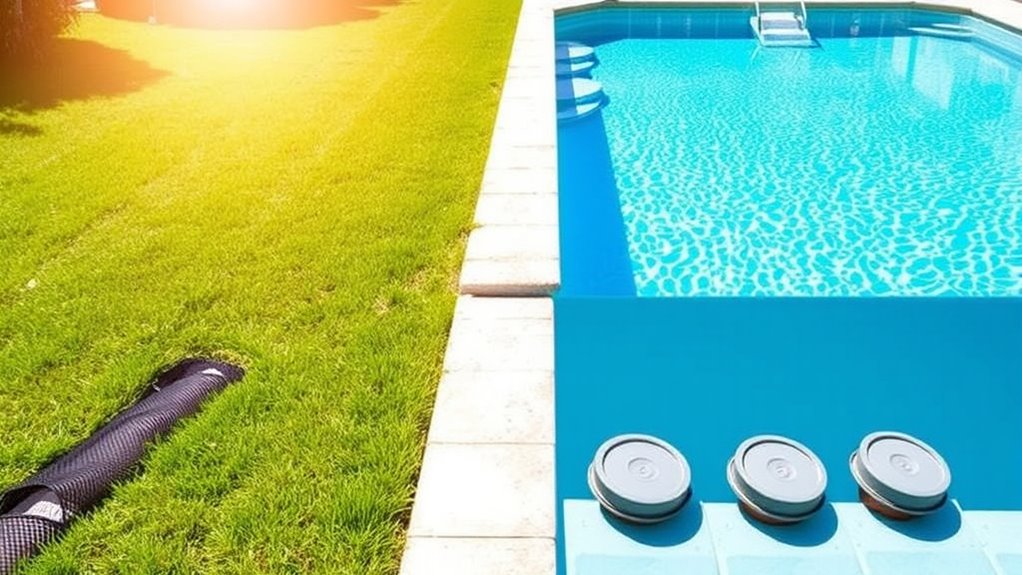
Standing water around your yard provides an ideal breeding ground for mosquitoes and other pests. To prevent this, regularly empty containers like buckets, flower pots, and bird baths. Check gutters and drain clogs to guarantee water flows freely. Fill low spots in your yard with soil or gravel to stop puddles from forming after rain. If you have a pond, consider adding fish that eat mosquito larvae. Keep your yard well-maintained by trimming grass and bushes, reducing shaded areas where water might collect. Remove unused tires or debris that trap water. Be aware that water stagnation can lead to increased mosquito breeding. Additionally, electric bikes and accessories can be used for yard maintenance and transportation. Proper yard maintenance not only improves aesthetics but also reduces standing water and mosquito populations. Incorporating self-reflection into your routine can help you stay motivated to maintain a pest-free environment. By eliminating standing water, you reduce mosquito populations and create a less inviting environment for pests, helping keep your pool area bug-free and more enjoyable. Regularly inspecting your yard for hidden water pockets can further prevent mosquito breeding sites.
Incorporate Natural Repellents and Plants

Incorporating natural repellents and plants is an effective way to keep pests away from your pool area without relying on harsh chemicals. Certain plants naturally repel bugs, creating a barrier that deters them from approaching your space. To maximize effectiveness, consider these options:
- Citronella plants – Known for repelling mosquitoes and other flying insects.
- Lavender – Its scent deters mosquitoes and moths while adding a pleasant aroma.
- Marigolds – These flowers produce compounds that repel mosquitoes and some beetles. Additionally, selecting plants with natural pest-repellent properties can enhance your outdoor pest control efforts.
Using AI safety measures in designing pest control strategies can help ensure that your outdoor environment remains safe and eco-friendly. Plant these around your pool perimeter or in pots nearby. Not only do they help keep bugs at bay, but they also add beauty and an invigorating scent to your outdoor space. Natural repellents are eco-friendly and safe for your family and pets, especially when combined with plant-based pest deterrents that are non-toxic and environmentally sustainable. Incorporating knowledge about refrigeration cycle principles can also help in maintaining a comfortable and pest-free pool environment by ensuring proper ventilation and temperature control.
Install Bug-Repellent Devices and Traps
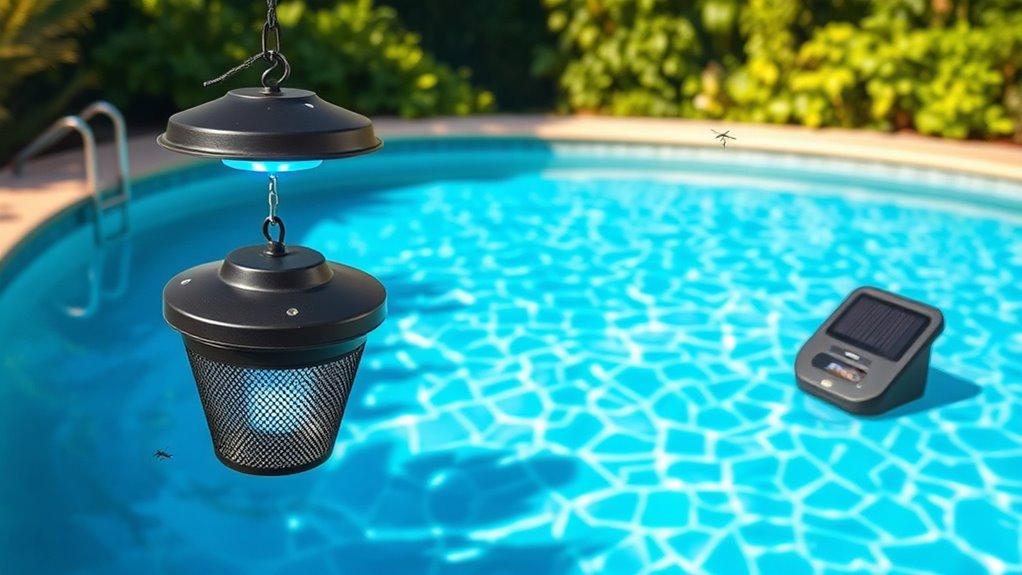
Installing bug-repellent devices and traps is an effective way to reduce pests around your pool area. Bug zappers and UV light traps attract insects and eliminate them quickly, keeping bugs away from your swimming space. Citronella candles and torches create a barrier of scent that deters mosquitoes and flies. You can also set up sticky traps to catch flying insects before they reach the water, reducing the chance of pest breeding nearby. Place these devices strategically around your pool, focusing on shaded and breezy areas where bugs tend to gather. Regularly clean and maintain traps to guarantee they stay effective. Incorporating sound design techniques can enhance the ambiance and further discourage pests by masking their presence. Additionally, selecting the right trap types can maximize pest control efficiency. Understanding the breed characteristics of common pests can help tailor your pest control methods for better results. For example, cartridge upgrades for bug zappers can improve their effectiveness in certain environments. Combining these tools with other pest control methods gives you a better chance of keeping your pool bug-free and enjoyable all season long.
Keep the Surrounding Area Clean and Tidy

Keeping the area around your pool clean and tidy is essential for preventing bugs from settling nearby. When you remove debris, insects have fewer places to hide and breed. Regularly perform these three tasks:
- Clear leaves, grass clippings, and trash from the yard.
- Mow the lawn frequently to eliminate hiding spots.
- Store outdoor equipment, toys, and furniture properly to prevent clutter.
Use Safe Insecticides When Necessary
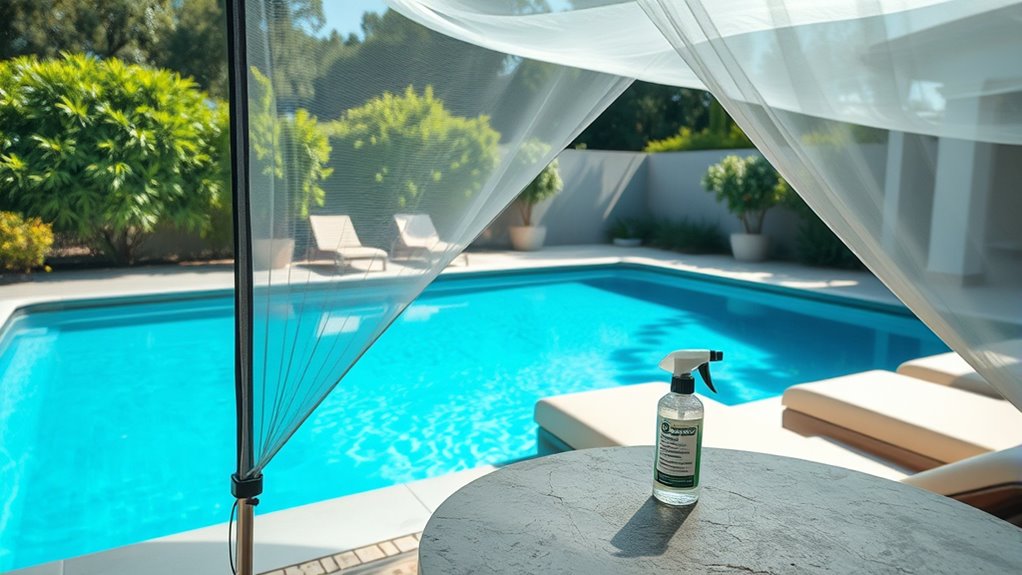
When you notice an increase in bugs despite maintaining a tidy yard, applying safe insecticides can provide extra protection for your pool area. Choose insecticides labeled as safe for use around children and pets, and follow the instructions carefully. Use them during early morning or late evening when bugs are most active. Consider applying targeted sprays to areas where bugs gather, such as shrubs or standing water. To give you a clearer idea, here’s a quick overview:
| Insecticide Type | Target Bugs | Safety Tips |
|---|---|---|
| Botanical Sprays | Mosquitoes, flies | Use outdoors, avoid windy days |
| Residual Sprays | Ants, spiders | Spray around perimeter, keep away from water |
| Aerosol Sprays | Wasps, bees | Use sparingly, only when needed |
Using insecticides responsibly helps keep bugs away without harming your loved ones. Additionally, understanding public health considerations can help you choose the safest options for your family. Proper exfoliation with glycolic acid can also improve skin texture around your pool area, reducing areas where insects might hide. Regular yard maintenance can further minimize insect habitats in your outdoor space. Incorporating targeted insect control methods can enhance the effectiveness of your efforts and minimize chemical use. Employing integrated pest management strategies can lead to more sustainable and effective pest control.
Frequently Asked Questions
How Do I Identify Which Bugs Are Most Attracted to My Pool?
You want to figure out which bugs are most attracted to your pool. Pay attention to common pests around water, like mosquitoes, flies, or beetles. Notice when they appear most often—early mornings, evenings, or after rain. Look for their presence near lights or standing water. By observing their activity and locations, you can identify the pests drawn to your pool and take targeted steps to keep them away.
Are There Eco-Friendly Options for Bug Prevention Around Pools?
You want eco-friendly options for bug prevention around your pool. Consider planting natural repellents like citronella, basil, or lavender nearby, as they deter bugs without harmful chemicals. You can also use citronella candles or install solar-powered bug zappers that are safe for the environment. Keeping your pool area clean and free of standing water also reduces breeding sites, helping to naturally decrease bug populations without relying on harsh chemicals.
How Often Should I Check and Replace Pool Covers or Screens?
Imagine uncovering your pool, only to find a messy surprise. That’s why you should check your pool covers or screens weekly, especially during bug season. Look for tears, debris, or sagging areas that could invite unwanted guests. If you notice any damage, replace or repair them promptly. Regular inspections guarantee your pool stays bug-free and pristine, giving you peace of mind and more time to enjoy your swim.
Can Certain Types of Lighting Deter Bugs Near My Pool?
Certain types of lighting can help keep bugs away from your pool. You should consider using yellow or sodium vapor lights, as they emit less ultraviolet light that attracts insects. Avoid bright white or blue lights, which tend to draw bugs in. Keep your outdoor lighting away from the pool area, and turn off lights when not needed. This simple change can markedly reduce bug activity around your pool.
What Are the Signs of a Bug Infestation in My Pool Area?
Think of your pool area like a garden that’s suddenly overrun with weeds. If you notice an uptick in dead bugs floating or a swarm of buzzing insects near the water, it’s a sign of an infestation. You might also see dark, sticky spots or spider webs around the edges. These clues tell you it’s time to act before the problem gets worse and ruins your relaxing swim.
Conclusion
By taking these steps, you’ll create a nearly bug-free oasis around your pool. But remember, pests are always lurking, waiting for the tiniest opening. Keep vigilant, maintain your defenses, and stay ahead of the bugs before they find a way in. With a little effort, your backyard paradise can remain peaceful and bug-free—until the next unexpected invasion. Are you prepared to keep those unwanted guests at bay? The choice is yours.
